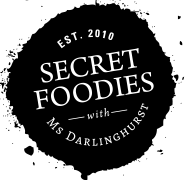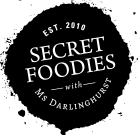Delicious food, dazzling venue, and Champagne, Champagne, Champagne
The lights were twinkling, the food all ordered and prepped and the Champagne was on ice. Secret Foodies was hosting their second Champagne event with the Champagne Bureau of Australia, an event that sold out in the record time of less than 6 hours. And the secret venue? Vine in Double Bay.
Pairing an entire dinner party with Champagne can be a daunting idea. Everyone knows Champagne is the perfect party starter, the toast of every fine celebration. But we’re often too scared to drink it through an entire meal. What if I don’t match it perfectly? What if the Champagne gets lost amongst my heavy, flavoursome food?
Our Champagne Degustation event was an evening of discovering and all about demystifying any preconceptions of Champagne and food pairing.
To help us with this task was Head Chef Drew Bolton. No stranger to the art of French ways Drew is a trained pastry chef who worked for quite a while at Baroque Bistro when it was in The Rocks.
Together he worked with Elisabeth Drysdale from the Champagne Bureau Australia to match 5 exceptional Champagnes to our degustation menu.
We started with a glass of Canard-Duchêne Cuvée Léonie on arrival before guests took their seats.
After a quick Q&A with Elisabeth we were in to the first course, of roasted oyster with yuzu, sake and espelette butter paired with a glass of Taittinger Prélude Grands Crus Cuvée.
Then came some fun cigar like wafers filled with the very French dish of chicken liver parfait with spiced bread and pineapple chutney paired with the delicious Lallier R.012 NV.
For mains we moved on to a rustic flounder grenobloise served with Pol Roger Brut Vintage 2006 and then roasted duck with quince, duck heart, walnut and celery paired with Moët & Chandon Grand Vintage 2006.
For dessert we had a light Neufchatel mousse with preserved summer fruits, meringue paired with the Alfred Gratien Cuvée Brut Rosé NV.
It was a deliciously decadent evening- one to remember!
For those curious about Champagne pairing and wanting to know more, here are the questions and answers from our talk with Elisabeth Drysdale. Happy Champagne and food pairing at your next dinner party!
Why is Champagne so unique and different from other sparkling wines?
Only Champagne comes from Champagne the region,- only the wines made from this small northerly region 1.5hr from France can be called Champagne.
What makes it so different to other sparkling wines?
Firstly the terroir which is unique to the region, giving the wines its special style. The cold climate, the chalky soil, the water and the tradition of blending (its taken hundred years of creation) all make Champagne unique. It is a very restricted and controlled appellation – embracing some 280,000 vineyard plots.
Australia is the 6th largest market. Last year we imported over 8.1 million bottles.
What’s the best way to serve Champagne?
– Champagne is best drunk chilled but never iced. The younger and livelier the Champagne, the cooler it should be served (8ºC). A mature or vintage Champagne will be perfect at 10ºC. Over-chilling will mean that the wine is too cold to release its aromas and flavours.
– A 750ml bottle will give you roughly 6-8 glasses.
– Want to know, how to open a bottle correctly? Undo the wire cage, hold the cork in the palm of your hand and twist the bottle holding it at the bottom, the cork will come out of is own accord.
– Which glass? To fully appreciate a Champagne wine you must give it the glass it deserves. Its volume and height must be enough to allow the bubbles the space to form and rise to the surface, whilst allowing the temperature to remain as constant as possible. The ideal shape is that of a tulip, the Champagne saucer is one to avoid as the aromas and bubbles have too much space and are soon lost into the air.
– How to wash the glass? Rinse the glasses in hot water without any trace of washing-up liquid; let them drain until dry, then store them upright sheltered from dust. The residues of washing-up liquid can inhibit the formation of the bubbles.
How can we start or develop our palette for tasting Champagne?
With a range of aromas and flavours, Champagne can be easily paired with almost any dish from aperitif through to dessert.
Champagnes are all different from each other: different vineyards, different plots, different grape varieties, vintages, blends, aging periods and styles. We have an array of wines to suit many tastes and dishes.
Developing your senses
– First of all can you actually hear the wine? The pop of the Champagne cork and the sound of the bubble ignites one of your first senses;
– Let’s look at the colour of the wine: the eye can distinguish the paleness of a wine, which can show a young and crisp Champagne to a deeper gold colour reflecting a more mature wine. A yellow green colour shows a Chardonnay style wine, whilst a yellow with pink highlights show a wine made from black-skinned grapes;
– Now, let’s smell the wine: your nose can perceive woody or citrus aromas or recognise hints of flowers or fresh almonds;
– Finally – let’s taste! The palate experiences the coolness, the tingle of effervescence and an aromatic persistence which varies from wine to wine.
I know a lot of people start their meal with Champagne but are there any pointers on serving Champagne throughout an entire meal such as tonight?
– Admittedly, champagne is the perfect aperitif, with its mouth-watering acidity and fast-acting, refreshing effect, but with the right foods, one can get even more out of their drinking experience. Champagne fits with most types of food. The bubbles and the acidity can cut through butter sauces and dishes with cream etc…
– When it comes to pairing Champagne and food, you can go by: the heavier and stronger the dish, the fuller and more developed the Champagne;
– With the aperitif and entrée serve a lively blanc de blancs Champagne. Fresh, lively, invigorating blancs de blancs Champagne, based on chardonnay grapes, and non vintage brut Champagne are ideal. They offer a particular combination of freshness and succulence, lightness of texture, fruity delicacy and zest of citrus;
– With the main course and dessert, serve a more rounded than powerful Champagne with lasting softness and opulence. Choose Champagne that is more fleshy than powerful, typically, more mature such as a blanc de noirs Champagne (only from black grapes) that is supple on the palate and infinitely long, with honest, robust, fruited aromas
– Rose Champagne is also delicious as an aperitif particularly rose Champagne whose soft, silky textures and fresh, discreet aromas express the predominance of the Chardonnay grape. They are ideal with Foie gras on canapés of gingerbread, cocktail sticks of ham on the bone and pineapple, prunes with bacon.
Are there any combinations we should avoid?
– Many of the snacks traditionally served with the aperitif – peanuts, roasted almonds and other nuts, olives, crisps and other nibbles with strong flavours-are too salty, smoky or greasy to do justice to the subtle, delicate bouquet of Champagne.
– Spicy, hot, strong tasting dishes; foods with a crisp texture or those that are excessively sweet and bitter (such as chocolate).
– Dishes with a liquid or insubstantial texture; sharp tastes of lemon or vinegar, olives and pickles; marinades& garlic.
To see all the photos from the night, please visit it our Facebook page.
Vine Double
2 Short St, Double Bay NSW 2028
02 9363 0010
http://http://vinebar.com.auhttp://vinebar.com.au


